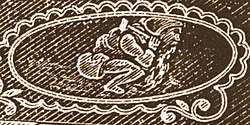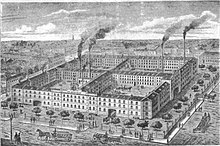German sewing machine factory
| German sewing machine factory by Jos. Wertheim
|
|
|---|---|
| legal form | Corporation |
| founding | 1863 |
| resolution | 1940 |
| Reason for dissolution | deletion |
| Seat | Frankfurt-Bornheim |
| Number of employees | 600 |
| Branch | Textile engineering |
The German sewing machine factory was founded by Joseph Wertheim in Frankfurt am Main in 1863 . The company soon became the largest German sewing machine manufacturer. By 1920 the factory in Frankfurt-Bornheim had produced around 1.5 million sewing machines, a large number of which were exported to Australia and South America. Production was relocated to Spain in 1932 and the company was deleted in 1940. The brand name Wertheim existed until 1975.
history
The twenty-eight-year-old mechanic Joseph Wertheim from Rotenburg an der Fulda came to Bornheim in 1862 , which at that time was still at the gates of Frankfurt. He had taken over the general agency for sewing machines for the American company Wheeler & Wilson for southern Germany and founded a sales subsidiary on a site between Burgstrasse and Petterweilstrasse, north of the Bornheimer Haide . He set up a workshop for the manufacture of spare parts at Grosse Friedberger Strasse 7. In 1863 he set up his first sewing machine factory in Hanau at Schloßgasse 7, where 1,000 sewing machines had already been produced by 1865. At the end of 1867 he built a new factory on Burgstrasse, which started operations in 1868 with 80 workers. Three years later, 300 workers were employed.
On May 6, 1873, the company was converted into the " Aktiengesellschaft Deutsche Sewing Machine Factory von Jos. Wertheim", whose shares were only issued to employees. In the same year a branch in Barcelona was established. In 1883 the annual production was already 35,000 sewing machines, which were manufactured by 600 workers on around 350 machines. The factory site now occupied the entire street block between Burgstrasse, Eichwaldstrasse, Petterweilstrasse and Germaniastrasse with around 7800 square meters. ▼ Wertheim was meanwhile the largest employer in Bornheim. A significant part of the production was exported to Australia and South America. The factory had two steam boilers with a heating surface of 185 square meters , two steam engines with a combined power of 95 horsepower , two cupolas and a foundry in which molded parts were manufactured according to its own patents.
From 1875 the company was run by two managing directors, Samuel Guckenheimer and Carl Wettach. They ran the business until 1890, when Ernst Wertheim, the eldest son of Joseph Wertheim, joined the management.
On May 31, 1883, a fire broke out at midday in the eastern factory building , which housed the joinery , foundry , part of the lathe and paint shop, and the strong easterly wind caused it to spread to the western building; Roof trusses and ceilings collapsed and about 600 sewing machines were destroyed. The cause of the fire was presumably negligent handling of fire in the paint shop. The damage was covered by insurance. As a result, around 150 workers had to be laid off in 1884 because of 25% production backlog.
In 1907, the sewing machine factory acquired a 30,000 square meter plot of land near Bonames train station on Frankfurter Berg to build a foundry, which was opened in 1908. ▼ In the same year the one millionth sewing machine from the production of the German sewing machine factory was delivered. In 1911 an iron foundry was built. By 1918, total production rose to around 1.5 million sewing machines.
In 1920 the branch of the sewing machine factory founded by Joseph Wertheim in Barcelona in 1870 was converted into the "Rapida SA", which was managed by a son of Joseph Wertheim, Karl Wertheim (Carlos Vallin). From 1932 onwards, the entire production facility in Frankfurt was dismantled and sewing machine production was relocated to Barcelona. The National Socialist city administration tried to erase any memory of the German-Jewish Wertheim family. In 1936 the factory buildings in Bornheim were demolished and in 1938 residential houses were built on the site. The IHK files were deleted in 1937, and the company was finally deleted ex officio in 1940.
The company Teves Maschinen und Armaturenfabrik took over the foundry on Frankfurter Berg in 1940. In 1943 the Olivetti Group took over the "Rapida SA" in Barcelona, where sewing machines were still produced until 1975 under the name "Wertheim".
Well-known models
- Electra
- Griffin
- Rhenania
- Saturn
- Saxonia
- Superba
- triumph
- Triplex
Production numbers
| year | production | Total production | Employee | Remarks |
|---|---|---|---|---|
| 1862 | ? | ? | ? | |
| 1863 | ? | ? | 28 | |
| 1864 | 350 | 350 | ||
| 1865 | 650 | 1,000 | 90 | |
| 1866 | 700 | 1,500 | ||
| 1867 | 1,500 | 3,000 | ||
| 1868 | 4,000 | 7,000 | Opening of the factory in Frankfurt-Bornheim | |
| 1869 | 6,200 | 13,200 | ||
| 1870 | 7,500 | 20,700 | ||
| 1871 | 8,200 | 28,900 | 300 | |
| 1872 | 9,100 | 38,000 | ||
| 1873 | 10,000 | 48,000 | ||
| 1874 | 12,400 | 60,400 | 380 | |
| 1875 | 14,600 | 75,000 | ||
| 1876 | 16,800 | 91,800 | ||
| 1877 | 21,000 | 112,800 | ||
| 1878 | 25,300 | 138,100 | ||
| 1879 | 27,900 | 166,000 | ||
| 1880 | 31,000 | 197,000 | ||
| 1881 | 32,000 | 229,000 | 540 | |
| 1882 | 34,000 | 263,000 | ||
| 1883 | 35,000 | 298,000 | 600 | May 31, 1883 major fire |
| 1884 | 26,000 | 324,000 | 450 | 150 layoffs |
| 1885 | 25,000 | 349,000 | 440 | |
| 1886 | 27,000 | 376,000 | ||
| 1887 | 25,000 | 401,000 | ||
| 1888 | 24,000 | 425,000 | ||
| 1889 | 23,000 | 448,000 | 480 | |
| 1890 | 20,000 | 468,000 | ||
| 1891 | 21,000 | 489,000 | ||
| 1892 | 20,000 | 509,000 | ||
| 1893 | 18,000 | 527,000 | ||
| 1894 | 18,000 | 545,000 | ||
| 1895 | 18,000 | 563,000 | 500 | |
| 1896 | 19,000 | 582,000 | ||
| 1897 | 22,000 | 604,000 | ||
| 1898 | 23,000 | 627,000 | ||
| 1899 | 25,000 | 652,000 | Year of death of Joseph Wertheim | |
| 1900 | 26,000 | 678,000 | 520 | |
| 1901 | 28,000 | 706,000 | ||
| 1902 | 31,000 | 737,000 | ||
| 1903 | 36,000 | 773,000 | 560 | |
| 1904 | 45,000 | 818,000 | ||
| 1905 | 52,000 | 870,000 | ||
| 1906 | 50,000 | 920,000 | ||
| 1907 | 51,000 | 971,000 | ||
| 1908 | 54,000 | 1,025,000 | 620 | Opening of the Bonames iron foundry |
| 1909 | 54,000 | 1,079,000 | ||
| 1910 | 52,000 | 1,131,000 | ||
| 1911 | 53,000 | 1,184,000 | ||
| 1912 | 56,000 | 1,240,000 | May 1st fire in the new parts magazine | |
| 1913 | 54,000 | 1,294,000 | 580 | |
| 1914 | 36,000 | 1,330,000 | 380 | |
| 1915 | 32,000 | 1,362,000 | 320 | |
| 1916 | 25,000 | 1,387,000 | 280 | |
| 1917 | 20,000 | 1,407,000 | 240 | |
| 1918 | 18,000 | 1,425,000 | 220 |
Web links and literature
- NaeMaSchmiede.de
- German sewing machine factory by Jos. Wertheim at www.albert-gieseler.de
- Carlos Guilliard: The lost legacy of the Wertheims. The story of my German-Jewish family . Bastei Lübbe AG, Cologne 2018. ISBN 978-3-7857-2633-4 .
Individual evidence
- ↑ a b c d Volker Rödel: Factory architecture in Frankfurt am Main 1774-1924 . The history of the industrialization of the city of Frankfurt am Main in the 19th century (= contributions to urban development ). Societäts-Verlag, Frankfurt am Main 1984, ISBN 3-7973-0435-8 , p. 94-95 and 290 .
- ^ Carla and Heinz Schutt: The Bornheim book. Society in Bornheim , Frankfurt 1988, ISBN 3-926016-01-9 . P. 50
- ↑ Brendan Berk: Where the sewing machines once rattled . In: Frankfurter Rundschau . September 28, 2007.


